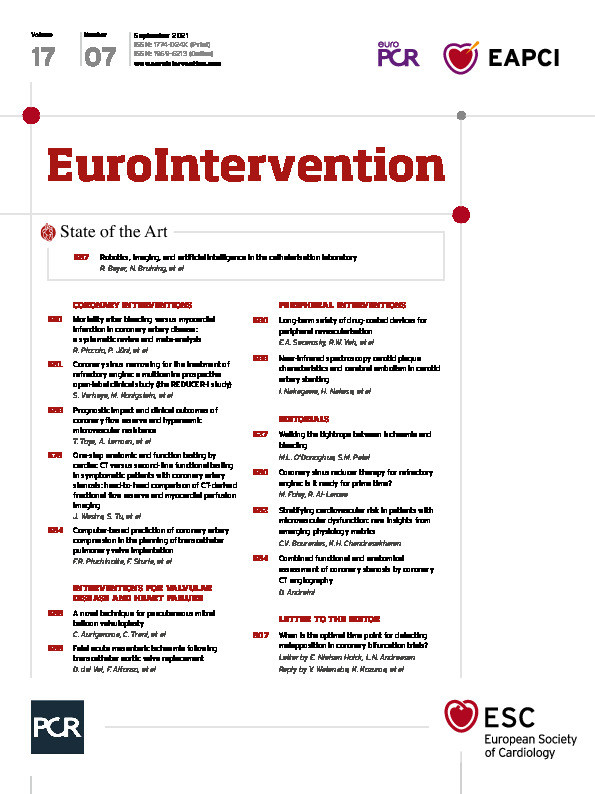Coronary microvascular dysfunction (CMD) has been increasingly recognised as a common cause of myocardial ischaemia and typical angina symptoms. Recent reports have examined the mechanisms that are responsible for the mismatch of demand-supply of coronary blood flow in patients with CMD, providing unique insights about the pathophysiological processes that are responsible for this disease1,2. Today, two different endotypes of CMD have been identified, the structural endotype that is associated with increased nitric oxide synthase (NOS) activity resulting in augmented coronary flow at baseline, and the functional endotype where there is a weak augmentation of coronary blood flow at stress due to a high microvascular resistance3. Several studies have shown that patients with the structural endotype have a higher-risk cardiovascular profile, suffering more often from hypertension, diabetes mellitus and diastolic heart failure indicated by a raised NT-proBNP than those with the functional endotype1,2. However, it is unclear whether there is a significant difference between the two groups in the incidence of major adverse cardiovascular events (MACE). This is of great interest in this population in particular, as cumulative data have shown that patients suffering from CMD not only have impaired quality of life but are also at risk of suffering MACE4.
The study by Toya et al, published in this issue of EuroIntervention, provides unique insights into the prognostic implications of coronary flow reserve (CFR) and hyperaemic microvascular resistance (HMR) in patients with unobstructed coronary arteries5.
The authors included 610 patients who had physiology assessment using a Doppler guidewire (FloWire®; Volcano Therapeutics Inc., Rancho Cordova, CA, USA) and were followed up for eight years. Patients with CMD (i.e., those with a low CFR <2.5 or high HMR >2.0 mmHg/cm/s) had worse outcomes than those with normal microvascular function. In this report, an abnormal CFR (<2.5) was not associated with a higher MACE rate; however, this metric was a predictor of events when it was treated as a continuous variable. Conversely, HMR was an independent predictor of events both as a numerical and as a categorical variable. HMR carried incremental prognostic information to CFR as their combination enabled better event prediction, resulting in a net reclassification improvement of 0.17 (95% confidence interval: 0.02-0.31, p=0.03) compared to standalone CFR. The limitations of this report have been acknowledged by the authors in the relevant section and include the absence of information with regard to the time of each event that did not allow a time-dependent analysis, the lack of information about the cause of death, and the fact that event reporting was based on the recollection of the patients. Despite these limitations, this study is important in the field, as it underscores the implications of the coronary microvascular physiology-derived metrics, and especially the effect of HMR, on clinical outcomes. The reported findings are expected to attract interest, motivate researchers to investigate further the prognostic value of microvascular resistance, examine its pathobiological effects on atherosclerotic disease progression, and introduce therapies that will aim to restore microvascular function.
Recent reports have provided mechanistic insights into the unfavourable effects of CMD on coronary physiology and biology. Studies have demonstrated that coronary endothelial dysfunction is associated with low endothelial shear stress values in the major epicardial arteries, which is a well-known instigator of plaque evolution6,7, while a recent report on patients with CMD has revealed genetic polymorphisms that induce endothelial NOS (eNOS) dysfunction which can promote plaque formation and destabilisation8. In line with these findings, intravascular imaging studies have shown an increased atheroma burden and lipid component in patients with CMD and revealed a significant association between raised HMR and vulnerable plaques9,10.
In view of the evidence supporting an increased MACE rate in patients with structural CMD and an adverse effect of a raised HMR on plaque morphology and physiology, there is an unmet need to identify these patients and introduce therapies that will aim to restore microvascular function. Expert consensus documents published recently have proposed a systematic approach for the diagnosis of CMD and introduced recommendations for the management of patients suffering from CMD3. Currently, the treatment algorithms are similar in patients with functional and structural CMD. However, as this report indicates, patient characteristics and clinical outcomes are different in the two groups. Therefore, it is essential to study further and understand the similarities and differences of the CMD endotypes and individualise therapy based on microvascular physiology metrics. This is likely to become feasible in future as several novel drugs have recently been introduced that aim to restore microvascular function, including therapies that target the increased vasoconstrictive response of coronary micro-vessels and are expected to decrease peripheral vascular resistance (i.e., the phosphodiesterase type 3 inhibitors or the endothelin receptor antagonists atrasentan and zibotentan)11. Whether this strategy will improve outcomes in patients with CMD needs to be proven in prospective appropriately sized clinical trials.
Conflict of interest statement
The authors have no conflicts of interest to declare.
Supplementary data
To read the full content of this article, please download the PDF.

